|
GREEN
fields and woodland tracts were too plentiful
and too near in the days when Decatur was given
its first park for it to be fully appreciated,
but seventy-five years later Decatur citizens
are glad that it once had a resident so
far-sighted and so generous as to make that park
possible.
Central park - Decatur's
first park - was given to the city July 10,
1855, by Captain David L. Allen and
Dr. Thomas H. Read, the donors specifying
that it was to be used for no other purpose than
a public ground and common park. For
twenty years it was nothing more than a public
square, surrounded by hitching racks. Once
it was rough and hilly, covered with brush and
weeds, the "worst place for snakes I ever saw",
said one early resident.
Gradually the hollows were
filled, as dirt was hauled in from excavations
for new buildings in the neighborhood. In
1859 a number of trees were set out.
Now it was a lovely spot of
green, with grassy level ground and plenty of
shade, a place where people may rest, and kind
of a place the donors had in mind many years
ago.
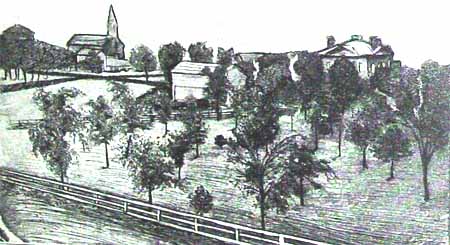
CENTRAL PARK IN EARLY DAYS, ABOUT 1865
The square is a part of what
was platted as the "North addition to Decatur"
in April, 1837, but it became known as the
Allen, McReynolds & Co.'s addition,
and that name appears in all realty
transactions. The addition is bounded by
North, Broadway, Wood and Water streets.
Other members of the company which platted it
besides David L. Allen, were Dr.
Thomas H. Read, brother-in-law to Captain
Allen, and James McReynolds.

FOUNTAIN IN CENTRAL PARK
(1877 - 1930)
When the square was laid out,
it was in the mind of Captain Allen to
give it to the railroad companies, then being
proposed, to be used as a site for a depot.
The railroads failed to materialize then, and
later the offer to donate it for a park was
made. After it came into possession
of the city, the city council had the hitching
racks built around it for the benefit of the
farmers. In those days it was called "the
new square."
Real improvement of the park
did not begin until June 1876, when the hitching
racks were removed, and gravel walks wee laid.
Then it was decided to install a fountain.
The fountain was purchased that year by
Lowber Burrows at the centennial exposition
in Philadelphia. On July 2, 1877, after
the fountain had been placed and work about the
park completed, the council adopted a resolution
to name the square Central park, and it was
opened "for the enjoyment of the public" July 3,
1877. The fountain stood in the park until
1930 when it was moved to the waterworks grounds
to make room for the M. L. Harry
memorial.
The first custodian for the
park was appointed in 1892. The park
commissioners were appointed by the mayor then
as follows: J. E. Bering, Peter Loeb,
Lowber Burrows.
OTHER PARK SPACES
Decatur had other places
which served the purpose of parks in the early
days.
Greenwood cemetery, with its
pretty natural surroundings, used to draw many
visitors in the first few years after it was
opened. It was within easy walking
distance of the town, was well laid out with
walks and drives, and well provided with shade.
After an objective point for a Sunday afternoon
stroll or drive it grew into popularity, and it
was not until other parks had been opened that
it began to lose that popularity.
Another place that took the
place of a park for a good many years for the
north end of town was King's Orchard, in the
vicinity of King and Marietta streets.
Nick Webber's beer
garden was popular for a number of years -- that
is, with a certain class of people. During
the days of the rolling mill in the '70s, it was
frequented by the men from that mill. It
was located between Franklin street and the
Illinois Central railroad about where Cantrell
street would be, if extended west. Being
remote from the built up section of the city,
there was no one to complain about wild parties,
fights and noisy carousals. Those were
taken more as a matter of course than they would
be now. There was always something doing
when excursions were run from Terre Haute, and
that city sent over a bunch of pleasure seekers.
The beer garden was a side issue of the
Webber
brewery. It existed for a number of years,
but finally was sold.
The tree covered Johns land
south of the hill was not a public park, but was
used by many as a picture ground, and many
Fourth of July and other gatherings were held
there. Because it was used by the public
so many years, Mrs. Jane M. Johns decided
to donate it to the city for park.
Eighteen acres are in the tract donated.
It is now known as Johns Hill park.
Bramble's pleasure garden,
adjoining the Imboden land, immediately
north of Greenwood cemetery, consisted of six
and one-half acres, with natural attractions.
It was well advertised and patronized during the
'70s as a place for outings. Ice cream
parlor, bath house, mineral springs, and skating
rink were available for the patrons.
Oakland park, now the
James Millikin University grounds, was
sponsored by the Citizens Street Railway
company, which built a horse car line out West
Main street to the Wabash tracks. This
park was the scene of many temperance and other
big meetings in the '80s and '90s.
For twenty years the Decatur
Trotting association, organized in 1890,
maintained a park for annual race meets on the
Brenneman land at the present intersection of
Broadway and Garfield avenue. These meets
brought huge crowds of racing enthusiasts and
noted horsemen. George A. Keller
was one of the secretaries that did much to make
the meets successful.
In 1890 fifty acres of the
Maffit and Starr & Mills land along the Sangamon
was set aside as a park, known as Riverside
park, which was leased by the Decatur Electric
Railway company. A car line was run to the
entrance, where the corner of Silas street and
Riverside avenue is now. It was extremely
popular for a number of years, having much
natural attractiveness, as well as entertainment
facilities.
Boating, bathing, picnics,
water carnivals, chautauquas, skating, had fifty
boats on the river, and there were other
privately owned boars, including three
steamboats. Often excursions were run to
this Decatur park from other cities.
FAIRVIEW
The original forty acres of
what is now Fairview park were laid out in 1857
as a fairground for the Macon County
Agricultural society. Deeds transferring
the land were not made out until 1863. The
deed for the east twenty acres was dated March
26, 1863, and was given by the executors of the
estate of William L. Powers. The
consideration was $600. The deed for the
west twenty acres was given May 2, 1863, by
Christian J. Barrackman, consideration
being $150.
A tight board fence was
erected around the entire forty acres. The
land then was all in timber, and enough ground
was cleared to make room for buildings.
The buildings erected included an ampitheater
with 5,000 seating capacity, farm products hall,
40 by 100 feet, mechanical and industrial hall
40 by 60 feet, fine arts hall in octagonal
shape, 40 feet in diameter, stalls for 500
cattle and pens for 500 hogs.
Good water supply was
furnished by six springs on the grounds.
The Macon County Agricultural
society was organized June 28, 1856, with E.
A. Jones as president; William Rea,
as vice president; William Martin,
treasurer; James P. Boyd, secretary; and
Samuel Powers, Jacob Hostetler, J. G.
Taylor and D. K. Wilson as
directors.
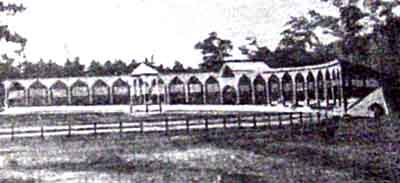
AMPITHEATER IN OLD FAIR GROUNDS
The first fair was held Oct.
9 - 10, 1856, and from that time until 1884,
county fairs were held each year, with the
exception of 1863, 1864, 1869 and 1870, when
Illinois state fairs were held on the grounds.1
In 1869 the society sold the
grounds to Macon county for $5,600. The
deed was signed by James H. Pickrell,
president, and James C. Lake, secretary.
Mayor M. F. Kanan
suggested in 1890 that the county lease the
grounds to the city of Decatur for a park.
He aroused sentiment in favor of the idea, and
the matter also was agitated by The Review.
On March 27, that year, a lease was signed.
The city took possession April 1. Terms
agreed on were $100 a year for the first ten
years, $200 a year for the second ten, and $250
a year for the third ten.
A voting contest to name the
park was inaugurated by The Review, and 135
names were submitted. Fairview, with 3,224
votes and Columbia, with 3,084, were the two
most popular names.2
Within the next few years
after the city took possession of the park,
considerable improvement was made. The
pavilion and custodian's home were erected.
Drainage, water, drives, and provided. In
1900 W. C. Hood, landscape gardener, was
employed to lay out and beautify the grounds.
From $2,000 to $3,000 a year was being spent on
improvements. This was the first work of
Frank D. Torrence, who became
superintendent July 12, 1901, serving until his
death, Jan. 13, 1928. His career was
remarkable for the generous and whole hearted
way he gave his whole life to the city's
service.
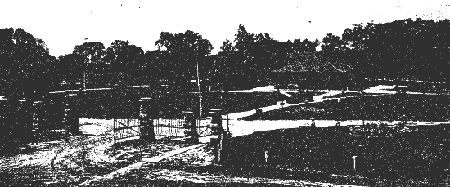
ENTRANCE TO FAIRVIEW PARK, 1908
In 1903 the city purchased
the land from the county, paying $8,000 for the
forty acres. In 1905 the ten acres to the
east, known as the Catto tract, were added, the
purchase price being $7,000. The addition
to the west, formerly the Dreamland amusement
park, a tract of ten acres, was bought in 1919.
Another tract to the west was bought from the I.
P. and L., and thirty-eight acres along Stevens
creek were added in 1928, being bought from the
Taggart heirs, at $250 an acre.
These various additions brought the acreage of
Fairview park up to a total of 121.25.
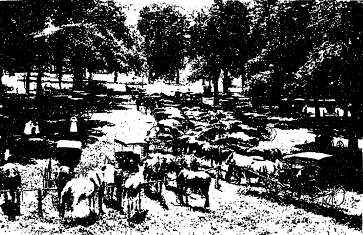
SCENE IN FAIRVIEW
In the days when signs read "Hitch Here"
instead of "Park Here"
The Dreamland amusement park
was established in 1905 by the Decatur Amusement
company, and Fred Given was named
manager. A score of citizens subscribed
the $40,000 invested. Ten acres were
bought from E. S. Baker. A theater,
dance pavilion, roller coaster, etc., were
built.
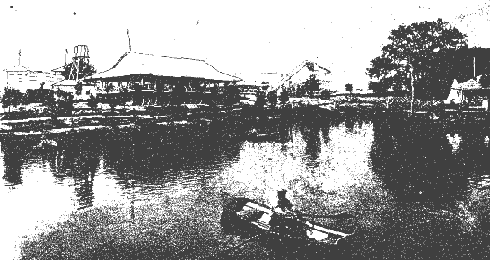
DREAMLAND PARK SCENE
<Click
Here for Additional Picture of Dreamland Park
Scene added by Sharon Wick)
For seven years the park was
operated, but it was not a success financially.
In 1919 the city bought the land and added it to
Fairview.
OTHER PARKS
Lincoln park was purchased by
the city in 1905. The gift of two
additional small tracts, one by B. B. Tuttle
and the other by Mrs. Caroline Powers
gave the park a total acreage of twenty-two.
In February, 1911, the city
purchased fourteen acres in the northeast
section of the city for a park, and it was named
Torrence park in honor of Park Superintendent
Frank Torrence. The name was chosen by
popular vote. Five acres were added in
1924.
Garfield park, two acres, in
East Main street, was donated to the city by
J. M. Clokey in 1892, when he laid out East
Park Boulevards addition, but was not developed
until in 1912.
Nelson park came into
possession of the city in 1912. The
original tract, 83 acres, was not bought
outright at first. J. S. Baldwin,
then city attorney, submitted a proposition that
the land be leased from its owner, E. Wayne
Ponting, at $2,000 a year for ten years,
with option of buying at any time within the ten
years for $20,000, the rental previously paid to
be applied on the purchase price. The
proposition was accepted by the council.
After five years the land was bought. This
park, like others, was named by a voting contest
in The Review, the public choosing in that way
to honor Judge William E. Nelson.
Creation of the Decatur park
district was brought about by the offer April
27, 1924, of Mrs. L. P. Walbridge and
Mrs. E. P. Irving to donate Faries park to
the city, in accordance with the wishes of their
father, Robert Faries. The
condition was made that a park district be
organized to take over management of that
property as well as all city parks.
An election was held on Aug.
5, 1924, to vote on establishing a park
district, boundaries of which would coincide
with the boundaries of Decatur township.
The proposition carried by a vote of 4,061 to
321. The park commissioners name at that
election were: George A. Caldwell,
James H. Galloway, George F. Hess, Howard C.
Schaub and W. Elmer White. When
Mr. White left the city, John McEvoy
was selected to succeed him. The board
elected Mr. Schaub as president of park
land. At the present time (1930) the park
board controls more than 800 acres. A
summary of the acreage, cost, and estimated
value of the parks is given here:
| Park |
Acreage |
Cost or
Estimated Value |
| Nelson |
187.49 |
$197,813.23 |
| Lake shore land |
72.11 |
6,107.61 |
| Big Creek land |
152.59 |
18,617.81 |
| Fairview |
122.39 |
60,120.00 |
| Faries |
158.60 |
88,780.00 |
| Torrence |
18.91 |
22,600.00 |
| Johns hill |
18.00 |
63,000.00 |
| North side |
20.26 |
24,319.08 |
| South side |
39.11 |
56,702.64 |
| Lincoln |
25.21 |
79,500.00 |
| Garfield |
2.80 |
11,200.00 |
| Jasper playground |
1.00 |
3,650.00 |
|
Totals |
818.47 |
$632,410.37 |
The 72.11 acres of land
designated as lake shore land were bought
from the Decatur Water Supply company.
----------------------------
1.
One of the features of the 1858 fair, as
reported by the secretary, James Shoaff,
was the horseback riding by thirteen members of
the fair sex, "all of whom rode gracefully, with
much ease, and creditably to themselves.
2.
The name, Fairview, was suggested by Mrs.
Helen W. Martin, wife of E. J. Martin,
then manager of the "Short Line railway", as the
Decatur electric was known. The name was a
combination, as one may see.
<PREVIOUS>
<NEXT>
<CLICK HERE TO
RETURN TO TABLE OF CONTENTS>
|